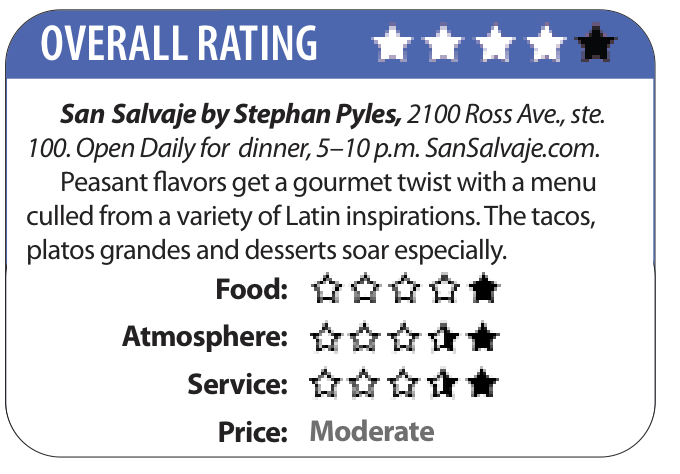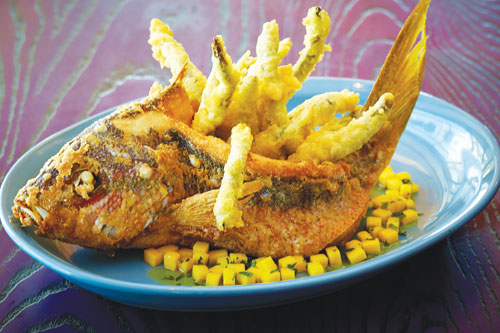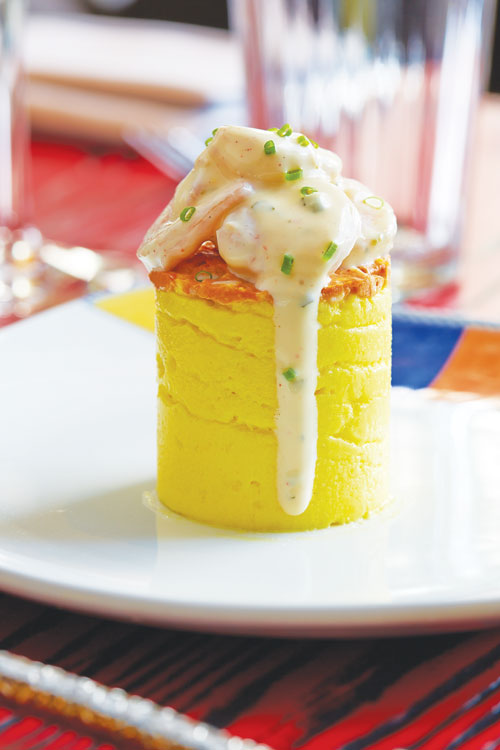Stephan Pyles reimagines South American cuisine at his new San Salvaje
ARNOLD WAYNE JONES | Executive Editor
When changes in ownership at the building that housed Stephan Pyles’ Samar — his multifarious, globally-inspired tapas restaurant catty-corner from his eponymous eatery along Ross Avenue — forced him to close for a remodel, he made some noticeable changes. The space is more open and light, with colorful artwork (shiny “balloons” made of metal; hand-painted stripped lizards attached to the walls) and a buoyant atmosphere. The hookahs are gone (for now, at least — maybe bring then back for Waterpipe Wednesdays?), but the bar still provides a pocket of social humming with inviting cocktails.
 But it turned out that more than just the walls and décor got a makeover; the menu and the concept got reworked, as well. What was expected to be a five-month project stretched to a year, and in that time, Pyles — always the most peripatetic of chefs, who absorbs how different cultures create memorable meals and refashions then with a gourmet twist — decided to go south for his new bill of fare … in fact, if it’s south of Harlingen, it’s probably finding its way on a plate at San Salvaje.
But it turned out that more than just the walls and décor got a makeover; the menu and the concept got reworked, as well. What was expected to be a five-month project stretched to a year, and in that time, Pyles — always the most peripatetic of chefs, who absorbs how different cultures create memorable meals and refashions then with a gourmet twist — decided to go south for his new bill of fare … in fact, if it’s south of Harlingen, it’s probably finding its way on a plate at San Salvaje.
Samar drew its culinary inspiration from across the planet, mostly Spain, India and the Middle East; its replacement, San Salvaje (Spanish for “savage saint”) explores Central and South American influences. The name itself is a paradox, with “salvaje” (savage) reflecting pagan roots, and “san” the imprimatur of Christian saints common in the culture. In that way, the menu is a mélange of the indigenous and the imported.
The differences can be subtle. Many dishes we know by one name are, with slight variations, familiar to others by another — whether you call ceviche, tiradito, sushi or crudo, it’s raw fish. The menu here lists “arepas, gorditas y empanadas,” three staples of Latin American cooking that vary in popularity by region (arepas more common in Colombia and Venezuela, gorditas in Mexico). And while plantains may look like bananas, they are starchier and the flavor profiles distinguish them.

DINING AS THEATER | The presentation of the whole red snapper, garnished with green beans, is food pageantry that’s also delicious.
The rangy menu — about 40 items including desserts, priced from $6–$28 with most around $10 — and the sizes encourage sharing and experimentation. You’ll want to take an experimental approach for many of the items, which contain unusual ingredients and combinations. Huitlacoche, a Mexican delicacy dating back to the Aztecs, is a corn fungus employed like mushrooms; the lucuma suspiro, a dessert made from a Peruvian fruit that resembles an avocado, produces a custard that tastes like butterscotch.
If any of those words frighten you, good. This is adventure dining, with just enough tweaks to soften the edges for curious but cautious palates. The huitlacoche empanadas ($10), for instance, are earthy but sweet, made even sweeter with the addition of guava. The foie gras tacu tacu ($18) — a rice-and-bean patty topped with a lobe of foie gras, then crowned again with caramelized banana — gives a glimpse of indulgence on a Peruvian peasant dish, its richness a cause for celebration.
Many of the flavors are deftly designed to allow the essence of the ingredients to breathe. The causa limena ($9) is a tower of chopped yellow fingerling potatoes, lightly seasoned but doused in a traditional spicy-shrimp sauce. Inside, the surprise of a soft-cooked quail egg spreads its emulsion, with each element blending with the others. That’s also true with the grouper tiradito ($10), where garlic, fennel, orange juice and EVOO combine for a unique marinade.
Tacos rear up on the menu as well. (Pyles’ Stampede 66 has its own taco bar — well worth a trip.) The duck (2/$10) is smoky and chewy, and the tangy tomatillo salsa soared. The squid taco (2/$8), however, was the menu’s most unexpected delight, though my dining companion preferred the humita ($12), a South American version of the tamale with sweet masa, elevated by a claw of avocado and diced lobster.

CAUSA FOR CELEBRATION | The traditional causa limena classico is a potato dish that packs the surprise of a soft-boiled quail egg inside. (Photos courtesy Kevin Marple)
Most of the above items are sharable or appetizer sized, but large entrees are offered as well. One of my favorite dishes is the feijoada (fayz-jwada), a kind of Brazilian cassoulet made here with heirloom beans and a generous medallion of pork cheek, braised until it has the velvety tenderness of a love sonnet. A ragout of greens (spinach, I’d say) with bits of citrus and hard spices undergirds the broth, and a crisp chicharron reminds you of the humble nature of this style of cuisine. It grounds you to another culture while conveying a comforting warmth without leaving a heavy feeling.
Just as good was the ropa vieja ($21) of stewed short rib, braised and compressed and served with stuffed plantains. For drama alone, the standout item is surely the fried red snapper ($28), a whole fish that you can both eat and which holds the pickled green beans. It’s not dinner theater so much as dining as theater.
With their out-of-the-box concepts and unique twists, the desserts here are as necessary as breathing. Only tres leches cake ($8) was a familiar hit (as was its tart strawberry sorbet). How do you explain the lushness of the lucuma suspiro ($7) being derived from a fruit, or the doughnut-like picarones ($6), which is actually a fried mash of squash and sweet potato? (You can justify a lot of fried foods if they are made from vegetables.
The banana corunda ($8) — a sugary, grainy pancake so intensely sweet from caramel and candied nuts that it gave me a post-dinner rush — captured what sets San Salvaje apart: A strange, exciting journey through the foods that bind us, culture to culture, palate to palate.
This article appeared in the Dallas Voice print edition July 4, 2014.



